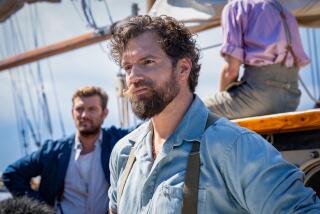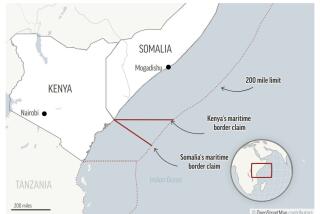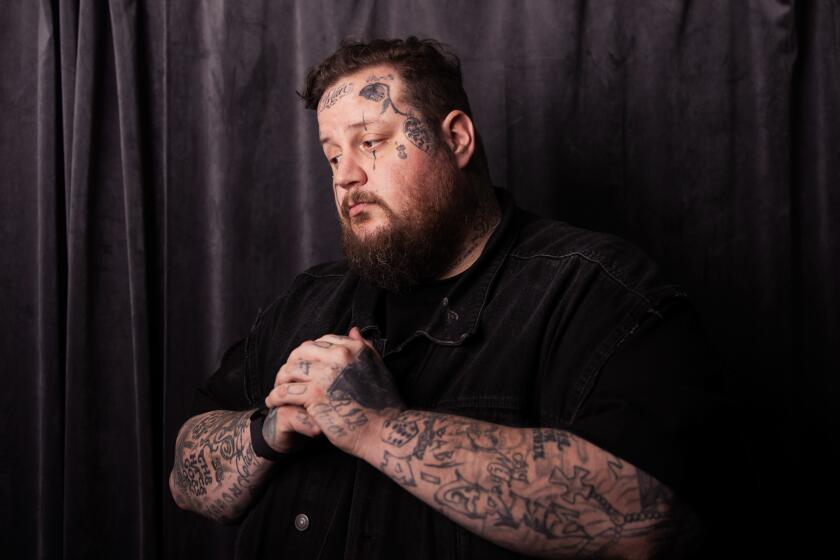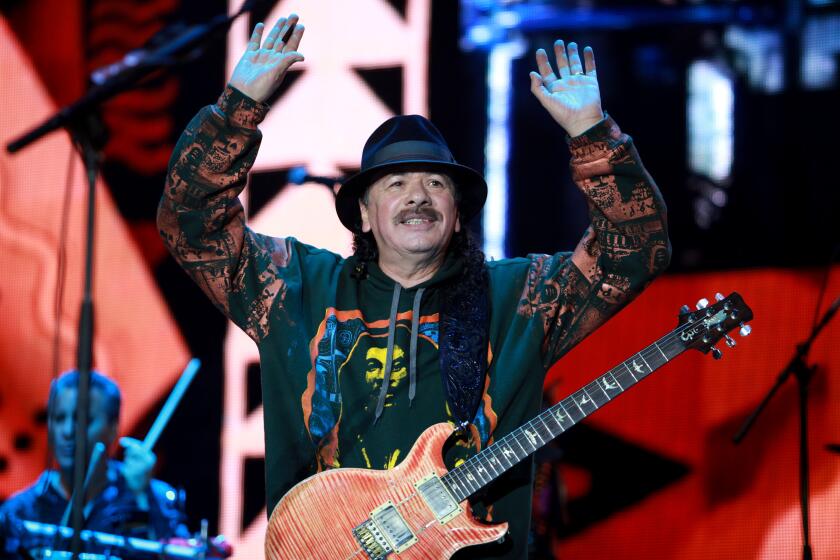‘Act of Valor’ must balance publicity, secrecy with Navy SEALs
- Share via
They’re among the most elite and mystery-shrouded members of the U.S. military, part of a traditionally anonymous group of alpha males known as the “quiet professionals” for their daring, clandestine missions like the raid that killed Osama bin Laden. But the secret world of the U.S. Navy SEALs is about to open up in dramatic fashion — in an unusual, independently financed action movie called “Act of Valor.”
In a moment of unprecedented public exposure, several active-duty SEALs play the lead parts in the film, which opens Feb. 24. Though their names don’t appear in the credits — listed instead are the names of Naval Special Warfare forces killed since Sept. 11 — the SEALs’ faces are clearly visible onscreen and in marketing materials for the combat thriller. It’s not only the SEALs’ images but their often fearless tactics that “Act of Valor” reveals, in electrifying action sequences filmed during training exercises with live weapons fire.
The casting of real SEALs creates a layer of intrigue and authenticity about “Act of Valor” for audiences, but the movie raises questions of propriety for some in the military community — the SEALs have been uncomfortably in the limelight since one of their teams conducted last May’s Bin Laden raid, and the hunt for the terrorist leader is the focus of yet another Hollywood movie, one that has become the subject of a Pentagon investigation about whether its director and screenwriter, Kathryn Bigelow and Mark Boal, had improper access to classified material.
Just how much America’s secret warriors should open themselves to the world is a complex issue. “The quiet professional means, ‘Do your job. Keep your mouth shut,’” said Ken Robinson, a terrorism and national security analyst and former special forces soldier who produced a 2005 NBC military drama with Jerry Bruckheimer called “E-Ring.” “A movie is a sword that cuts both ways. It shines a light on very brave, capable Americans. On the other hand, any time you crack open a door and give someone an insight into who you are, you give them an advantage. For some people, you draw the line at zero. Other people say, ‘Someone else is gonna tell our story badly, why don’t we tell people what we do?’”
“Act of Valor” is a hybrid of fiction and documentary-style storytelling — the film tracks an eight-man SEAL squad that undertakes a fabricated mission to recover a captured CIA operative and discovers a plot to sneak suicide bombers into the U.S. across the Mexican border. In addition to its cast — led by a couple of especially telegenic warriors named Chief Dave and Lt. Rorke (their real first names) — the movie features live grenades, free-falling parachuters, high-speed boats, helicopters, an aircraft carrier and a nuclear submarine. It’s a level of production that would make blockbuster filmmakers such as Michael Bay and Jerry Bruckheimer drool, obtained by two first-time feature directors and former stuntmen, Mike “Mouse” McCoy and Scott Waugh, for roughly $12 million.
The story of the small project, first conceived as a training film, then later embraced by the Navy and given a huge unexpected boost by the Bin Laden raid, is a dramatic yarn in its own right. Because it was begun as a recruitment video, the movie proceeded outside the normal Department of Defense channels for working with Hollywood, in which production companies submit a script for the department’s approval in order to gain access to personnel or materials.
How the military initially understood the project — as a documentary, a fictional film, a recruitment video — is unclear. “That’s like ‘Rashomon,’” said one DOD official who works regularly with Hollywood and was not authorized to speak publicly about the project. “Ask a different person, get a different story.”
Officially, “Act of Valor” “did not follow the normal DOD approval process for major motion pictures,” according to Rear Adm. Dennis J. Moynihan, the Navy’s chief of information. But the Navy has publicly embraced the film, which was overseen by the Naval Special Warfare unit, and determined that it poses no threats to the security of the U.S. or its stars, some of whom are now deployed overseas.
“We think it accurately represents a number of the acts of valor that have occurred over the last 10 years with respect to the SEAL teams,” said Adm. William McRaven, the head of Special Operations Command and a SEAL himself, answering a question at an industry conference in Washington, D.C., last week. . “We’re conscious of the fact that there are active-duty Navy SEALs here. I can tell you they all volunteered. There’s no concern on their part about their individual or the security of their families.... The film company that produced this had a very collaborative effort with the Navy and with U.S. Special Operations Command. So nothing displayed in there tips our sensitive tactics, techniques and procedures.”
McRaven and the SEALs have been under extra scrutiny of late, with Americans clamoring to know more about the men who killed Bin Laden and another group of parachuters from the same unit who rescued two aid workers from Somali pirates last month. Even as the public wants to learn about those SEALs — whose identities have been closely guarded by the Pentagon — some of McRaven’s fellow military officers have been urging him to share less information about operations.
“One of these days, if you keep publishing how you do this, the other guy’s going to be there ready for you,” retired Army Lt. Gen. James Vaught told McRaven at the conference. “And you’re going to fly in and he’s going to shoot down every damn helicopter and kill every one of your SEALs. Now, watch it happen. Mark my words. Get the hell out of the media.”
Real-deal SEALs
In the wake of all this unwanted attention comes a project conceived in a narrow window of time when the SEALs were, for the first time in their history, trying to raise their profile. The unlikely beneficiaries of this timing are McCoy and Waugh, the co-founders of a production company, the Bandito Bros., which specializes in action-heavy ads for brands like Mountain Dew and NASCAR.
In 2008, the Navy’s Special Operations branch solicited proposals for a recruitment film to address a DOD call for an increase in Special Ops forces to aid in the wars in Afghanistan and Iraq. The filmmakers, who had directed a short documentary about Naval Special Warfare boat teams, got the job, which brought with it access to the SEALs and their training maneuvers, but no money.
McCoy and Waugh’s liaison was a SEAL named Duncan Smith who had been charged with helping recruit 500 SEALS to the 2,450-man force in what was in 2008 a difficult recruiting environment. The SEALs were not paid for participating, and the action depicted was part of standard training exercises, according to the Navy.
Over the next two years, McCoy and Waugh, who supplied the initial financing themselves, spent 50 days filming training exercises in locations such as the Naval Base Coronado, Key West, Fla., and Fort Knox, Ky., and conducting on-camera interviews with the SEALs about their work. “The more Mouse and I hung out with them, the more they started to trust us,” said Waugh. “They told us stories from real missions. They told us, ‘I wish I could explain to my family what I do.’ We thought, ‘We really need to get our audience to feel what it’s like to be a Navy SEAL.’”
The filmmakers’ original intent, Waugh said, was to fashion the real “acts of valor” they had heard into a fictional script, with actors portraying the SEALs. At a certain point, however, they decided that men like Chief Dave and Lt. Rorke had a certain toughness and complexity that no actor could fake, and asked the SEALs themselves to star. “My analogy to them was, ‘Take “Top Gun,” pull Maverick out, and put in the real Maverick,’” Waugh said.
They enlisted “300” screenwriter Kurt Johnstad to construct a script that strung five acts of valor into a narrative, using their most cinematic training footage. They also added home front scenes that stretch the SEALs’ acting skills outside their combat comfort zones — a barroom chat, a doorstep farewell to a pregnant wife, a funeral.
The Navy did not allow The Times to interview the “Act of Valor” SEALs, though a reporter was permitted to speak with one off the record at a private screening. Relativity Media, the studio releasing “Act of Valor,” provided transcripts of interviews conducted with some of the SEALs, including Lt. Rorke, who said he originally declined McCoy and Waugh’s request to participate in the film.
“We all said no, because of the history of the quiet professional and not advertising the nature of the work,” said Rorke, in real life a 38-year-old Bronze Star holder from California. “These are things that are in the fabric of our ethos and who we are as a warfare community and a culture. So it’s, it’s a big gap or, or kind of aside to do something like this. Now, we were asked to do it by the leadership … [which] kind of opened the door for a little bit of a gray area there. And I think for the small group of us that participated … the recognizable guys in the picture, we thought there was a unique opportunity there.”
McCoy and Waugh raised additional cash with the help of Legendary Entertainment founder Thomas Tull, an investor in the Bandito Bros. who also finances big-budget studio movies. They cast little-known TV and video game actors to play opposite the SEALs as the movie’s civilians and villains, and shot additional sequences in far-flung locations including Cambodia and Ukraine to add to the global scope of the terrorism plot.
The Navy did not exercise creative control over the movie, but it reviewed more than 1,500 hours of footage, according to spokesman Moynihan, and mandated changes to certain scenes — to avoid offending an ally, revealing key interrogation tactics, and portraying a SEAL exercising undue force.
In February 2011, Waugh and McCoy finished the film and enlisted sales agents to begin shopping it to distributors. On May 2, Bin Laden was dead, Navy SEALs were front-page news and a low-budget action movie suddenly became a hot commodity. Waugh said he and McCoy withdrew their movie from the marketplace for a month, not wanting to appear to capitalize on the raid. At the time, other high-profile SEAL film projects were circulating, including the long-in-the-works Bigelow and Boal film, which eventually landed at Sony Pictures and is scheduled for release in December.
A unique opportunity
In June, Relativity bought “Act of Valor” for $13.5 million and a hefty prints-and-advertising commitment that will mean releasing it on at least 2,500 screens.
“Seeing real Navy SEALs do what they really do, based on real events, real stories, is pretty interesting and not something you come across every day,” said Tucker Tooley, co-president of Relativity. “This may have been a window in time, a moment, and all the pieces fell into place. I’m not sure that happens again.”
In early audience surveys, the movie is appealing most to young men, a group Relativity has been actively courting. The trailer was featured on the website for the military-themed video game Battlefield 3, and four spots for it aired during the Super Bowl. As one enthusiastic YouTube commenter said of the trailer, “This is a mans [sic] movie for men hardcore action the best realistic tactics ever no need for acting this is thier [sic] job.”
The SEALs’ hidden identities have created some unusual marketing dilemmas, however. “There’s quite a spotlight on a group who have operated for years in silence,” said Terry Curtin, Relativity’s president of theatrical marketing. “We want to respect that and we’re operating in accordance with their code for anonymity. We can’t entirely trot them out on the ‘Today’ show.”
When online commenters speculated that “Act of Valor” might be a trick “found footage” movie like “Paranormal Activity,” the studio released online videos of some of the SEALs discussing the film. There’s also a novelization under the imprimatur of espionage writer Tom Clancy and a soundtrack featuring country artists Keith Urban and Lady Antebellum.
The Navy has allowed the SEALs to attend a few select screenings, plans to allow at least one television interview and to have SEALs present at “Act of Valor’s” Los Angeles premiere Feb. 13. “We can’t bring everybody out to see the Navy, to see an aircraft carrier or a destroyer or visit with SEAL units,” said Moynihan. “But the American people watch TV and movies. If we can’t take them to where we are, maybe we can go where they are.”
Times staff writers John Horn and David S. Cloud contributed to this report.
More to Read
The biggest entertainment stories
Get our big stories about Hollywood, film, television, music, arts, culture and more right in your inbox as soon as they publish.
You may occasionally receive promotional content from the Los Angeles Times.











